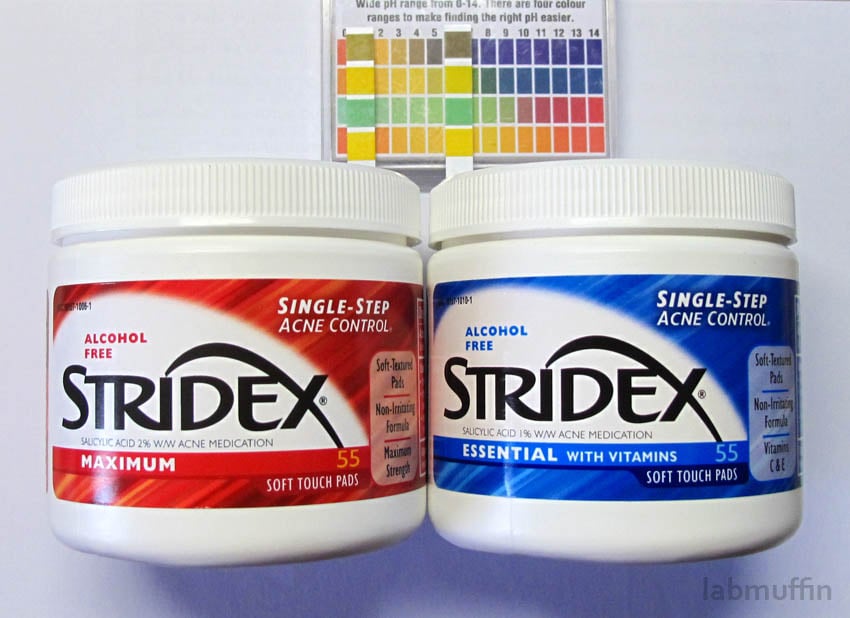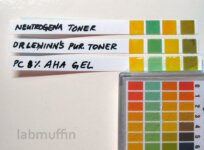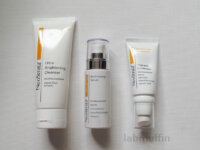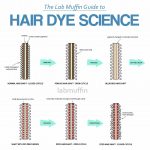Continuing on my pH and hydroxy acid kick, today’s Fact-check is on the influence of pH and alpha and beta hydroxy acids.
Hold onto your hats for this one – it gets a bit technical – but hopefully I can translate it to something understandable. Further questions are welcome and I will try to answer them as best I can!
A brief recap of what these things are:
What Is pH?
pH is a measure of a substance’s acidity or alkalinity (also called basicity) – it gives you information about the concentration of hydrogen ions (H+) floating around in something water-based. Low pH means more acidic, high pH means more alkaline.
pH values for some common substances:
- Battery acid = 0-1
- Stomach acid = 1-2
- Lemon juice = 2-3
- Vinegar = 2-3
- Fizzy drinks = 3
- Orange juice = 3.5
- Shampoo = 5.5
- Normal skin = 4-6
- Pure water = 7
- Blood = 7.4
- Seawater = 7.5-8.4
- Toothpaste = 8
- Baking soda slurry = 8-9
- Standard soap = 9-10
- Milk of magnesia = 10.5
- Ammonia = 10-11
- Oven cleaner = 13-14
- Lye = 13-14
pH 7 is considered neutral – that is, neither acidic nor basic.
More information: What the Hell Is pH?
What are AHAs and BHAs?
AHAs and BHAs are alpha and beta hydroxy acids, respectively. These are chemicals which are found in many plants naturally, and have an exfoliating effect on the skin.
AHAs are less oil soluble than BHAs, so they supposedly can’t penetrate clogged pores as well, but AHAs have an additional moisturising effect.
More information: AHAs vs BHAs
AHAs and BHAs are acids, which means they can donate H+ ions, the things that make acids acidic. For glycolic acid, it looks like this:
For every acid, there’s a measurement called a pKa which tells you how much the acid prefers to be as the version on the left or the right.
The structure on the left is uncharged, and is also known as the free acid form.
The structure on the right is a negatively charged ion, known as the dissociated or ionised form. When the acid turns into this negatively charged ion, it also forms a H+ ion.
(Side note: Even water (H2O) falls apart to a tiny extent to donate H+ in water – hence why the pH of water is at a medium pH 7.)
The pKa values of some AHAs and BHAs are:1
- Glycolic acid: 3.83
- Lactic acid: 3.86
- Madelic acid: 3.41
- Malic acid: 3.40
- Salicylic acid: 2.97
The lower the pKa, the more acidic the acid is, and the more it likes to donate H+ ions.
The most important factor determining how much a particular acid ionises and falls apart is the pH of the solution it’s in. It just so happens that when the pH is equal to the pKa, it’s at 50/50 – half the acid is in free acid form, and half is dissociated.
So if you have a tube of 8% glycolic acid at pH 3.83, for example, you have a tube that has 4% glycolic acid as a free acid, and 4% as the charged, dissociated H+ and glycolate ions.
How does this make a difference on my face?
The fact that AHAs and BHAs behave differently at different pHs is very important in skincare because the stratum corneum is oily. If you’ve been following this blog, you’d have heard me say many times that oily things like dissolving uncharged, oily things, and don’t like dissolving charged, polar, watery things.
To pass through the oily stratum corneum and into the skin to do their work, the hydroxy acids need to be in their uncharged, free acid form…which we can control by playing around with pH.2
If you’re mathematically minded, or you’ve suffered through a year of university chemistry, you’ll be able to calculate exactly what percentage of each AHA or BHA is in free acid form at a given pH. I plugged in a bunch of values into a spreadsheet to show the effect of pH on % free acid for the three most popular AHAs/BHAs, glycolic, lactic and salicylic acid:
(These are approximate – the %s will vary with concentration as well. I actually showed one of my high school students this spreadsheet in response to one of his questions… he rightfully made fun of me for spending my free time making pKa spreadsheets. The pain of being an unrepentant nerd.)
Now, if you multiply the percentage of free acid by the concentration of AHA or BHA present in the bottle, you can work out how much is ready to pass through your stratum corneum. For instance, at pH 2.5, a 8% glycolic acid treatment will have 7.64% glycolic acid in its active form (multiply . To get the same amount of active glycolic acid in a glycolic acid treatment at pH 4.5, you would need a product with 43% glycolic acid!3
As you can see, the lower the pH, the more free acid we have. So why not make all products at pH 0? Because it would burn our faces off. And low pHs all burn our faces off to varying degrees – depending on how hardy your skin is, different people will be able to tolerate different pHs, and you’ll know from the stinging, redness, itchiness, dryness and peeling whether your skin can handle it.
For a more exact calculation, you can use this free acid calculator.
But wait… there’s more!
OK, so you’ve applied your pH 3.83 8% glycolic acid to your face, and the 4% that’s uncharged has all absorbed (theoretically that is, nothing ever all absorbs!) – what happens to the other 4% sitting on top of your skin? Does that just stay charged and shut out forever?
The answer is no. The acid likes to be a certain percent free acid, so now that the free acid’s gone, that essentially leaves space for some of the dissociated ions to become uncharged free acid. This can then go through your skin. So theoretically, at any pH, ALL of the HA could turn into the uncharged free acid and will be absorbed.
This is why some HA products at higher pHs (sometimes labelled as “buffered products”) are said to be time-release – instead of being able to absorb all the free acid straight away, some of the HA sits on top of the skin and slowly turns into absorbable free acid over time. This has the advantage of decreased irritation – both from too much HA, and from the low pH.
However.
Even though theoretically all of the HA will eventually be absorbed, the HA that’s in your skin is also being removed and broken down in your body. If the pH is too high, the HA will be absorbed too slowly, and will end up too dilute in your skin to have an effect (if you pour a bottle of Coke into a swimming pool and drink all the water, you won’t taste the Coke even though you’ve drunken a whole bottle of it).
For an idea of how much pH affects absorption, one study (PDF link) compares the absorption of 5% glycolic acid and 5% lactic acid, and pHs of 3 and 7. At pH 3, total absorption of a 5% glycolic acid cream after 24 hours was 27% as opposed to 3.5 % at pH 7; with 5% lactic acid, absorption dropped from 30% to 10% when pH changed from 3 to 7. However, another study found that when the pH of a 10% lactic acid exfoliant was increased above pH 4, there were negligible effects on skin turnover.
Amendment: Salicylic Acid Is Special
There’s a slight caveat to this: salicylic acid, also known as BHA, is a bit special.
Salicylic acid is a larger molecule than most AHAs. This makes it quite oily – oily enough that having a little charge on the end might not make it all that less oily. This means that it can still work effectively at a higher pH, as demonstrated in these two studies.
(I wasn’t aware of these studies when I originally wrote this post, so the original recommendation of a pH of less than 3.5 for BHA products might not actually be necessary! Sorry about that.)
Take-home messages
– pH changes the amount of AHA in your product that will be absorbed into your skin.
– Lower pHs increase the amount of HA that can be absorbed, but also come with increased irritation and without time-release properties.
– A product that has a pH higher than the recommended range will still work, just not as well (and possibly so poorly that it won’t have any effect). A product with a higher concentration (%) of AHA can get away with a slightly higher pH and still be effective.
To achieve a happy medium, the rules of thumb for choosing an AHA or BHA exfoliant are:
- For AHAs, you should look for a product with a pH of less than 4, and a concentration of 4-10%
- For BHAs, you should look for a product with a concentration of 1-2% – pH doesn’t seem to make a big difference.
Notes
1. Some of these chemicals have more than one H+ which can come off, so if you Google their pKas you’ll find more than one value – the values I’ve quoted here are for the hydroxy acid H+.
2. Some charged species can pass through skin via special mechanisms, but this doesn’t really happen for AHAs and BHAs.
3. You can compare different products containing the same HA, but you can’t compare products containing different HAs – each HA has a different potency, so you might need less of a HA to do the same job as another HA.
References
Leveque N et al., Comparison of Franz cells and microdialysis for assessing salicylic acid penetration through human skin, Int J Pharm 2004, 269, 323.
Wolverton SE, α-Hydroxy acids. In Comprehensive Dermatologic Drug Therapy, 3rd ed., Elsevier, 2012, 570.
Kraeling MK & Bronaugh RL, In vitro percutaneous absorption of alpha hydroxy acids in human skin, J Soc Cosmet Chem 1997, 48, 187.
Merinville E et al., Three clinical studies showing the anti‐aging benefits of sodium salicylate in human skin, J Cosmet Dermatol 2010, 9, 174-184.
Bashir SJ et al., Cutaneous bioassay of salicylic acid as a keratolytic, Int J Pharm 2005, 292, 187-194.
[lastupdated]









This was so, so good. First year chem was, ahem, eleven years ago, but I could still understand it.
Question: how do I know what the pH of a product is without buying it and testing it myself? Or if googling doesn’t work (e.g. someone such as yourself testing it)?
I can’t express how much I adore your fact check articles!
Follow-up question (also related to your ACV/aztec clay article): I used to use ACV as a pre-shampoo rinse on my scalp to deal with itchy flakies. Sometimes I diluted it with water, sometimes I just poured it over my (already wet) scalp. I’m wondering whether the optimal pH and concentrations are different for use on the scalp vs the rest of the face/body? Thanks!
This article is bloody amazing. Thank you for clearing up some acid uncertainty!
This article is amazing!! I love the chart too! Since I’m not mathematically minded – Do you mind sharing what formula you used?
what a fantastic post. Glycolic used to be my favorite chemical exfoliant but now I think I ought to stick to salicylic.
Do you have a favorite salicylic product you recommend?
I like Paula’s Choice 2% BHA Liquid!
hi Michelle. what would free acid level be for 5% mandelic acid at ph level of 3?
I was wondering what do you think about this study and how it fits into what you said here.
https://www.ncbi.nlm.nih.gov/pubmed/15725565
The researchers tested how well 2% salicyclic acid preparations at pH 3.3 and 6.9 exfoliate the skin. Their results showed that there was no difference in exfoliation capability between lotions in different pH levels. The solution with higher pH also caused less skin irritation and damage to the skin barrier.
The paper concluded:
“In light of this, our data indicates that the quest to increase the amount of free, non-dissociated SA is, in fact, counterproductive as the more acidic preparations resulted in skin irritation and barrier disruption.”
Any comments on this?
I personally find salicylic acid not to be very good at exfoliating surface dead skin cells . Aha better .
I’m reading up on this at the moment, will update once I’ve worked it out!
I’ve had a dig around and I’m not entirely convinced that high pH salicylic acid will have the same effects as low pH. The study (as far as I could tell, it doesn’t spell it out exactly) checked desquamation after 6 hours and found that higher pH and lower pH salicylic acid loosened the same amount of stratum corneum cells, but pH does affect salicylic acid flux (1, 2), so it’s likely that any deeper effects are lessened at higher pH. AHAs are hypothesised to work via both acting directly on desmosomes and increasing epidermal turnover, so if penetration to the epidermis is required for that second effect (I’m guessing so but I could be wrong), then that won’t happen at higher pH. I haven’t found any studies on salicylic acid and other epidermal/dermal effects, but there are a few on increased collagen etc. with AHAs. The salicylic acid formulations used in the study also contained >10% ethanol and 5% propylene glycol, so in the absence of penetration enhancers the penetration is likely lower. It is good to know that if a lower pH salicylic acid is too irritating then a higher pH salicylic acid is still effective for straightforward desquamation though. I’d be interested to see a study on the histological differences between higher and lower pH salicylic acid treatments after a few weeks, and with lower amounts of penetration enhancers.
Thanks for your insights. Always a pleasure to learn from people smarter than you 🙂
I accept your explanation as far as AHAs are concerned, but with SA I’m not totally convinced. Mainly because SA is known to penetrate the skin is fairly significant quantities, and when applied on a large surface area can cause salicylism. That would mean it quite easily penetrates through the entire skin. I’m not sure whether this has any bearing on its keratolytic effects though.
This study showed that vehicle affects percutaneous penetration a lot. Unfortunately, I didn’t see any mention of pH levels of the tested formulations.
http://www.ncbi.nlm.nih.gov/pubmed/10026401
Most of the salicylism case studies I found were patients with psoriasis or ichthyosis, which means impaired barrier function.
The vehicle in that study and some similar ones I’ve found are usually lipophilic e.g. mineral oil or petrolatum. In a purely lipophilic vehicle, there wouldn’t be a pH, and more importantly, salicylic acid would remain in unionised/neutral/free acid form, which is what the low pH conditions would be trying to mimic to enhance penetration. I wonder why there aren’t any water-free salicylic acid formulations in skincare? It seems to me that would be great for penetration without the irritation that comes with low pH… maybe it’s a “cosmetic elegance” issue.
Hi Michelle ! I was wondering if Dr Dennis Gross’ all-over blemish solution would be an example of a lipophilic vehicle?? The ingredients are Salicylic Acid (2.0%) Inactive Ingredients: Bisabolol, Cyclopentasiloxane, Dimethicone Crosspolymer, Dimethicone/Vinyl Dimethicone Crosspolymer, Dimethicone/Vinyltrimethylsiloxysilicate Crosspolymer, Disodium EDTA, Farnesol, Menthol, Phenoxyethanol, Squalane, Ubiquinone. I have emailed the company’s customer care team asking them why their product will work at a pH above 5 and am hoping they will explain that it is because of this! Otherwise i wasted my moneyyyyyyyyyyyyyyyyyyyy ;_; haha
Hello! There’s some evidence that salicylic acid can penetrate at higher pH – I talk about it at the end of my YouTube video! Around 3:57 https://www.youtube.com/watch?v=-w2v841ib7g
Possibly non-polar enough that pH doesn’t matter… oh interesting, I guess I will just have to use the product and decide if it has an effect for myself then. Thanks for the link, it’s awesome news to me that you are making youtube videos!
But the product you espouse, Paula’s Choice 2% BHA appears to have a PH of 6, from the tests I’ve done using PH strips.
Mine tests at pH 3-4 – what sort of strips did you use and what was your method?
Ah Michelle, your posts are so interesting! I wish it wasn’t so late at night right now otherwise I would read your entire blog in less than two hours!
Thank you! I’m so glad you enjoyed reading 🙂
I love you for this explaining 🙂 This is fantastic article, I was seeking the information about undisociated amount of lactic acid at various pH, now I get this. Greetings from Poland, thank you so much 🙂
If the salicylic acid is ph 2.97 , then why does your chart say it has already at %75 effectiveness at ph 2.5 ? wouldn’t it start to drop at ph3 ? and be in single digits by ph4 .
just seems that it would be completely free at its pure ph value
When pH = pKa, the free acid is at 50%, so at pH 2.97 it’s at 50% and has dropped to 48% by pH 3.
ph 2.5 at %4 salicylic acid is how many time stronger than Ph 3.5 at %3 salicylic acid ?
You can plug the numbers into this free acid calculator I made 🙂
aaaaaahhh coolness thanks
I just found your blog while researching the pH of glycolic acid! This post is absolutely amazing in it’s content and your ability to explain! Am so glad I found it, will be bookmarking as one of my favorites!
Thank you so much! 😀
Michelle, how does one deal with a pH lower than 4 but at the same time keep the viscosity of the gel? Any suggestions on thickeners that work well at that lower pH? thanks, Todd
Hi Todd! I’m not a cosmetic chemist, so unfortunately I don’t have any formulating tips. Try the Chemist’s Corner forum or the Beauty Brains site 🙂
Making use of a rheology modifier that stays stable even at a low pH is a perfect idea. Xanthum gum is stable within the pH of 2-12. So, that’s a great option. You can try different grades of xanthum gum in case you don’t like the regular xanthum gum. Xanthum gum soft (not used this grade before) works best based on the experiences of other cosmetic formulators.
HEC is another great option. HEC comes in different grades so you may want to ask your supplier the pH stability of the grade he/she sells. I use HEC to formulate gel serums with AHA. Final pH: 3.1. And the viscosity doesn’t change at all.
Hi Michelle,
Reading your article makes my mind leaving full. I never thought BHA and AHA could be so useful and significant when it comes in everyday beauty arsenal. I am using products that I think I could benefit and provide good looks. I hope next time you will share more beauty related products. Thanks for sharing these ideas.
Hi Michelle,
So many things to learn about AHAS and BHAS here in your post. I have to check the ingredients of my skincare products.
Great post. Thank you so much.
Thank you 🙂
Hi Michelle, thank you for posts! The thing which remained unclear to me is if the mechanism of exfoliation and irritation the same? I mean what causes skin irritation is just excessive exfoliation? If not, what then irritates?
And the second question a bit connected to the first one – is it possible to make a solution of, for example, apple cider vinegar to make a DIY exfoliator or it will be irritative and ineffective?
Excessive exfoliation can cause irritation, but not all irritation is excessive exfoliation… hope that makes sense!
It’s possible but it won’t be very effective – vinegar has acetic acid which isn’t a hydroxy acid.
You mentioned the charges form will eventually will become uncharged and absorb giving ‘slow release effect” so what about washing your face, scrubbing and exfoliating? Wont these remove the form left behind trying to give extended release effect?
Yep it will – leave-on products should be used after washing!
Thank you so much! It was really helpful and am facing some problems when I use AHA’s and BHA’s am loosing the consistency of the cream by using TEA at neutral level am again getting the consistency but the free acid works well at low pH values can you please let me know how can I maintain good consistency of the cream at low pH value.
Hi am a little confused about the math , could you please break it down ?
You stated that at a ph level of 2.5.. with 8% glycolic treatment . The active form will be 7.64.
But then , you said to get the same amount in a ph of 4.5 you will need 43%glycolic acid
When I did the math I got 14.4% instead of 43%. What am I doing wrong ?
Not sure… are you doing a K calculation? Did you convert everything to mol/L?
Thank you for this article Michelle. Finally found a scientific answer about BHAs and AHAs and how pH affects them ❤️
So with a leave on chemical exfoliant, such as the Paula’s Choice 2% BHA, to get the maximum benefits, is it best to use a toner before or after? I have searched this and got conflicting information. And what about toner and AHAs as well?
Unfortunately, the study linked for salicylic acid has a very low sample size. I don’t think it’s enough to make any conclusions from, so the < 3.5 pH recommendation should still stand
I disagree, the logKow for the salicylate ion is in exactly the right range for it to penetrate skin nicely, so by default we should assume it penetrates unless there’s evidence going the other way.
Hi Michelle,
If 3.5ph can burn or sting your skin, Why Paulas choice 2% BHA doesnt feels any burning or stinging sensation? is there any possible explanation on this?
Your skin might be used to it, it also has some soothing ingredients in it.